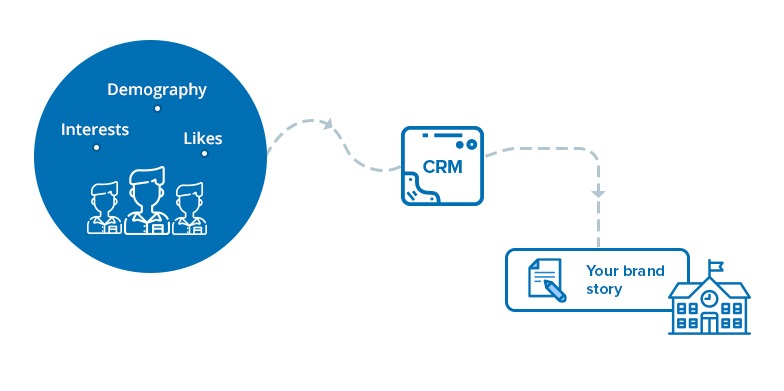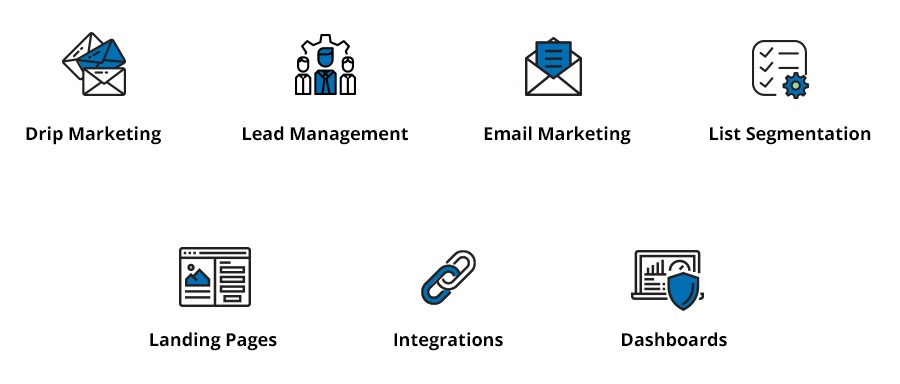Personalized student relationships are vital for meeting university enrollment targets. Today’s prospective students can easily research and compare multiple institutions online, quickly dismissing those that fail to connect with them personally.

University customer relationship management systems transform this challenge into an opportunity by enabling targeted, personalized communication at scale. By tailoring outreach to each student’s unique interests, academic goals, and background, institutions can effectively demonstrate their value proposition and build the meaningful connections that drive enrollment decisions.
Your Brand Story
Your university’s unique story – from its history and values to cutting-edge research – needs consistent presentation across all channels, from social media to in-person recruitment. This unified messaging is essential for attracting and converting prospective students.

Like retail brands, universities must engage their audience through compelling storytelling. A CRM system serves as the central platform for delivering this narrative while streamlining operations through AI-powered automation, improving both student communications and administrative efficiency.
You first need to know what your students want from a school. What motivates them? What are they passionate about? A CRM for universities program can give you just that information. You can change up your brand’s message to meet their needs as you gather data from your various recruitment campaigns and efforts.
A CRM lets you track data and analytics from your recruiting and marketing efforts so that it strikes a chord with prospective students. They want to know what makes your institution better than all the others they could apply to, and a CRM is what your university needs to get potential future students to apply there.
Understanding CRM in Higher Education
Definition of customer relationship management (CRM) in higher education
Customer Relationship Management (CRM) in higher education is a strategic approach that focuses on stakeholder management and nurturing relationships with a wide range of stakeholders, including prospective and current students, alumni, faculty, staff, and corporate partners.
By leveraging technology, CRM systems collect, analyze, and act on data to enhance student engagement, retention, and overall experience.
An integrated CRM platform enables higher education institutions to streamline communication, automate workflows, and provide personalized support throughout the entire student lifecycle.
This holistic approach ensures that every interaction is meaningful and contributes to the student’s journey from recruitment to graduation and beyond.
The journey of CRM adoption in higher education institutions has been transformative over the past two decades. Initially, CRM systems were predominantly used for sales and marketing processes, focusing on attracting prospective students.
However, as the education sector became increasingly competitive, institutions recognized the broader potential of CRM solutions. They began to see the value in using CRM to manage student relationships comprehensively, improving student retention and outcomes.
Today, higher education CRM systems are indispensable tools that support institutions in providing a personalized and supportive experience for students, faculty, and staff. From recruitment to alumni engagement, CRM systems have become integral to the success of higher education institutions.
What Can a CRM for Universities Do?
Most colleges reach just about 34 percent of their enrollment goals. With a CRM that conveys the school’s brand to potential applicants, that statistic can improve significantly.

Drip marketing
One of the most helpful tools in CRM is drip marketing. It provides a visual workflow builder to lay out the paths to conversion you can build with your future students. When an event starts off your recruiting department’s workflow, a recruitment officer can send out an initial welcome email. Then they can send it again with a different subject if it goes unopened, ensuring personalized communication.
Lead and student lifecycle management
Another choice is to update the lead to warm if the potential student opens the email. Then the recruiter can see where all possible recruits are in their application process, and they’ll know more about how they’re feeling about possibly moving forward with the application process. This empowers a recruiter to try different methods of reaching out to them if the student seems receptive.
Also, with automated funnel movement, you can update the student journey automatically when a trigger event occurs. The admissions team can get instant notifications of an event that could lead to enrollment. These types of tools let the department act immediately to build that critical relationship with a possible future student through automated workflows.

Email marketing
Additionally, you can use email marketing to build and nurture relationships with students who are not at the point where they want to have real-time conversations about enrolling. You can build emails from our drag-and-drop builder and use several templates to personalize content to various email lists. You can create a series of emails that cngaged and wanting to learn more about the organization.
You can up conversion rates by specifically targeting particular email lists with certain emails at the right time in the recruitment process. With the analytics available for our email tool, you can replicate a future email that is successful in getting engagements by analyzing engagement metrics.
List segmentation
One of the best features of our particular CRM for universities is that you can create personalized relationships with future students through email lists that reflect their interests, activities, and demographic characteristics. This empowers you to show what your college can offer them. Smart list segmentation allows you to perform custom list actions, like sending an email to all of the leads on a list or even to a call center that auto-dials possible future students with targeted messaging.
Landing pages
Use our well-designed landing pages on your site to engage potential students. Your organization keeps its website domain, but we host the landing pages. Autoresponders grab potential students’ attention and keep them engaged with the promise of a real person reaching out to them soon to answer any questions they have, ultimately improving conversion rates.
Analytics from previously sent landing pages can help create more successful campaigns and improve outreach and engagement.
Integration
You can integrate our CRM with all of your other marketing apps and tools so you can capture leads from many sources and then sync the data with our CRM program. This reduces response times to future students, and you can create and build more meaningful conversations and relationships, which turns into more enrollments. Analyze all of your data from your various marketing outlets with our integration tools so that you can see emerging trends, try new ways to reach your audience, and repeat what is successful.
Dashboards
Your team can see their schedule for the day on their dashboard each morning. They will know who to follow up with and when. They will receive email and phone alerts to contact individual potential applicants. All conversations, whether phone, email, or chat, are recorded in one place so that recruitment officers can remember each person they have communicated with and plan the next steps as they guide each person towards enrollment.
Benefits of CRM for Higher Education
Unified view of constituent information
A primary benefit of CRM in higher education is achieving a unified view of constituent information through data integration. By integrating data from various sources – student information systems, enrollment management systems, and alumni databases – institutions gain a comprehensive understanding of their constituents.
This integrated CRM platform allows staff to provide personalized support, tailor communication, and make data-driven decisions that enhance the student experience. Breaking down data silos ensures that all relevant information is accessible in one place, providing a seamless experience for students, faculty, and staff.
With advanced document management features and real-time data analytics, higher education institutions can effectively manage the entire student lifecycle, from prospective students to alumni, ensuring that every interaction is meaningful and contributes to student success.
Improved efficiency and productivity
Implementing a CRM system in higher education institutions can significantly enhance efficiency and productivity. By automating routine tasks and streamlining communication, staff members can focus on more critical tasks that require human interaction. This not only reduces data entry errors and redundant work but also fosters better collaboration across departments.
A CRM system enables institutions to manage the entire student lifecycle, from lead to alumnus, in a unified and efficient manner. This holistic approach allows staff to provide personalized support and guidance to students, thereby improving the overall student experience.
Additionally, CRM systems help institutions track key performance indicators (KPIs) and make data-driven decisions to boost student retention and success. By leveraging these tools, higher education institutions can ensure that every interaction is meaningful and contributes to the student’s journey.
Implementing CRM in Higher Education
Implementing a CRM system in higher education institutions requires careful planning and execution. Here are some essential steps to consider:
Defining implementation scope
Begin by mapping key departments involved – from admissions to alumni relations. Create detailed requirements documentation outlining essential features and data management needs. Establish a cross-functional steering committee and set realistic timelines aligned with academic calendars.
Selecting the right CRM
Evaluate vendors based on higher education expertise and integration capabilities with existing systems. Focus on customization options, mobile accessibility, automated workflows, and security compliance. Consider total cost including implementation, training, and support.
Change management strategy
Create a clear communication plan with regular stakeholder updates. Identify departmental champions early, document new workflows, and establish feedback mechanisms. Develop a phased implementation timeline with clear success metrics.
Training and support infrastructure
Design role-specific training programs, including workshops, online resources, and reference guides. Establish a network of departmental super-users for ongoing support. Maintain documentation of common issues and solutions.
Measuring success
Define key performance indicators aligned with institutional goals. Conduct regular system usage analysis and gather user feedback. Schedule periodic system audits and optimize based on results. Document best practices and success stories to guide future improvements.
By following these steps, institutions can successfully implement a CRM system that enhances efficiency, productivity, and the overall student experience.
Change Management And User Adoption
Change management and user adoption are critical components of a successful CRM implementation. Here are some strategies to consider:
- Communicate the benefits: Clearly communicate the benefits of the CRM system to staff members, including improved efficiency and productivity.
- Provide training and support: Offer comprehensive training and support to ensure staff members are comfortable using the new CRM system.
- Address concerns: Address any concerns and questions from staff members, providing a clear understanding of the CRM system and its benefits.
- Monitor progress: Continuously monitor progress and provide feedback to staff members, ensuring a smooth transition to the new CRM system.
By focusing on change management and user adoption, institutions can ensure that their CRM implementation is successful and that staff members are fully engaged with the new system.
Now let’s look at some key strategies that can increase student admissions and boost retention.
Strategies For Student Retention And Success
Implementing a CRM system is just the first step in improving student retention and success. Institutions must also develop strategies to leverage the data and insights provided by the CRM system. Here are some effective strategies for student retention and success:
Personalized support
Use the CRM system to provide personalized support and guidance to students, enhancing the overall student experience.
Targeted interventions
Identify areas where students may need additional support and provide targeted interventions to improve student retention and success.
Data-driven decision-making
Track key performance indicators (KPIs) and make data-driven decisions to enhance student retention and success.
Collaboration
Facilitate collaboration between departments using the CRM system, improving communication and reducing data entry errors and redundant work.
By implementing these strategies, higher education institutions can maximize the benefits of their CRM systems and ensure that every student receives the support they need to succeed.
In Conclusion
Marketing and student recruitment come together in our powerful LeadSquared CRM for universities. Your admissions and recruitment teams will improve communication and relationship-building with future students, and it keeps marketers and recruiters on the same page. This connected system reduces costs, workload, response time, and makes it easier to work smarter, not harder.








